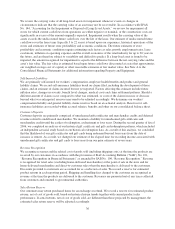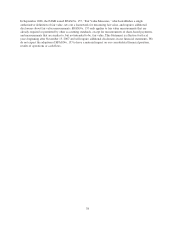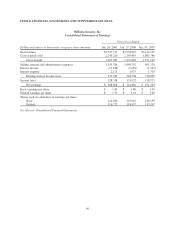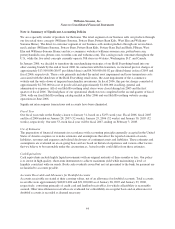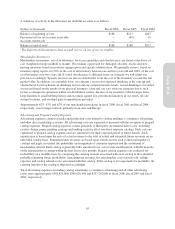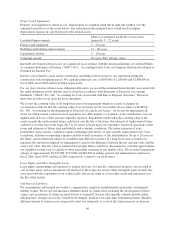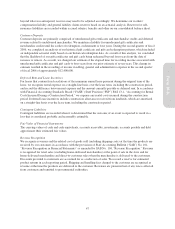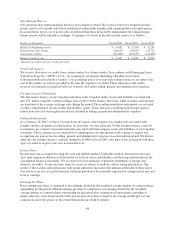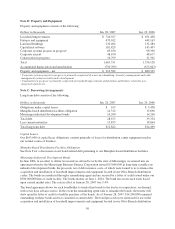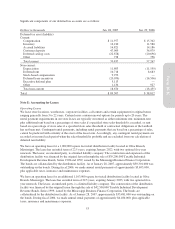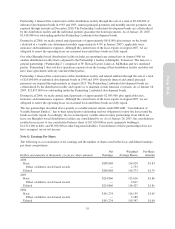Pottery Barn 2006 Annual Report Download - page 58
Download and view the complete annual report
Please find page 58 of the 2006 Pottery Barn annual report below. You can navigate through the pages in the report by either clicking on the pages listed below, or by using the keyword search tool below to find specific information within the annual report.
Property and Equipment
Property and equipment is stated at cost. Depreciation is computed using the straight-line method over the
estimated useful lives of the assets below. Any reduction in the estimated lives would result in higher
depreciation expense in a given period for the related assets.
Leasehold improvements
Shorter of estimated useful life or lease term
(generally 3 – 22 years)
Fixtures and equipment 2 – 20 years
Buildings and building improvements 12 – 40 years
Capitalized software 2 – 10 years
Corporate aircraft 20 years (20% salvage value)
Internally developed software costs are capitalized in accordance with the American Institute of Certified Public
Accountants Statement of Position (“SOP”) 98-1, “Accounting for the Costs of Computer Software Developed or
Obtained for Internal Use.”
Interest costs related to assets under construction, including software projects, are capitalized during the
construction or development period. We capitalized interest costs of $699,000, $1,200,000 and $1,689,000 in
fiscal 2006, fiscal 2005 and fiscal 2004, respectively.
For any store closures where a lease obligation still exists, we record the estimated future liability associated with
the rental obligation on the date the store is closed in accordance with Statement of Financial Accounting
Standards (“SFAS”) No. 146, “Accounting for Costs Associated with Exit or Disposal Activities.” However,
most store closures occur upon the lease expiration.
We review the carrying value of all long-lived assets for impairment whenever events or changes in
circumstances indicate that the carrying value of an asset may not be recoverable. In accordance with SFAS
No. 144, “Accounting for the Impairment or Disposal of Long-Lived Assets,” we review for impairment all
stores for which current cash flows from operations are either negative or nominal, or the construction costs are
significantly in excess of the amount originally expected. Impairment results when the carrying value of the
assets exceeds the undiscounted future cash flows over the life of the lease. Our estimate of undiscounted future
cash flows over the lease term (typically 5 to 22 years) is based upon our experience, historical operations of the
stores and estimates of future store profitability and economic conditions. The future estimates of store
profitability and economic conditions require estimating such factors as sales growth, employment rates, lease
escalations, inflation on operating expenses and the overall economics of the retail industry for up to 20 years in
the future, and are therefore subject to variability and difficult to predict. If a long-lived asset is found to be
impaired, the amount recognized for impairment is equal to the difference between the net carrying value and the
asset’s fair value. The fair value is estimated based upon future cash flows (discounted at a rate that approximates
our weighted average cost of capital) or other reasonable estimates of fair market value. We recorded impairment
charges of approximately $5,629,000, $733,000 and $82,000 in selling, general and administrative expense in
fiscal 2006, fiscal 2005, and fiscal 2004, respectively, related to our retail stores.
Lease Rights and Other Intangible Assets
Lease rights, representing costs incurred to acquire the lease of a specific commercial property, are recorded at
cost in other assets and are amortized over the lives of the respective leases. Other intangible assets include fees
associated with the acquisition of our credit facility and are recorded at cost in other assets and amortized over
the life of the facility.
Self-Insured Liabilities
We are primarily self-insured for workers’ compensation, employee health benefits and product and general
liability claims. We record self-insurance liabilities based on claims filed, including the development of those
claims, and an estimate of claims incurred but not yet reported. Factors affecting this estimate include future
inflation rates, changes in severity, benefit level changes, medical costs and claim settlement patterns. Should a
different amount of claims occur compared to what was estimated, or costs of the claims increase or decrease
46


